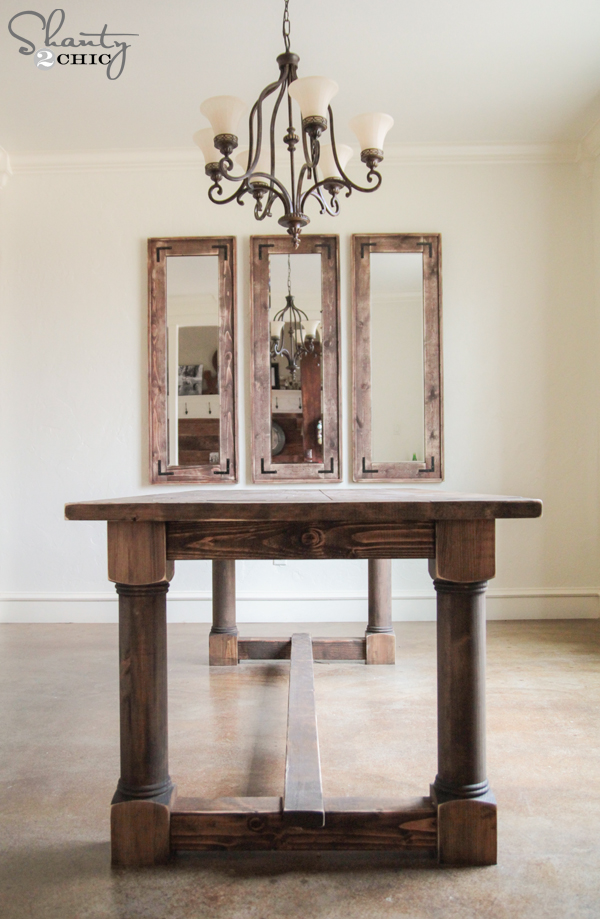The Impact of Dining Room Table Legs on Your Table's Overall Design
The Impact of Dining Room Table Legs on Your Table's Overall Design
Blog Article
Professional Tips for Setting Up Dining-room Table Legs for Maximum Security
When it comes to mounting eating area table legs, attaining optimum stability is paramount for both functionality and aesthetics. The process begins with picking the right materials and equipment, followed by precise placement and consideration of weight distribution. Each step plays an essential function in making certain that the finished item withstands daily use without compromising safety and security or design stability. Comprehending the subtleties of these aspects can dramatically influence the total end result. What particular strategies can enhance security even further?
Select the Right Legs
When picking the ideal legs for your dining-room table, it is important to take into consideration both capability and appearances. The legs you choose will significantly influence the total design and security of the table. First, examine the table's intended usage; if you expect constant events, stronger legs, such as those made from solid timber or steel, might be preferable, as they provide raised toughness and support.
Standard eating tables generally range from 28 to 30 inches in height, so make sure the legs straighten with this standard for convenience. Conical legs can add a modern touch, while turned legs might convey a more timeless visual.

Select Appropriate Equipment
Just how can the best equipment boost the security and long life of your dining area table? The option of suitable hardware is vital to making sure that the legs of your table are safely affixed and able to hold up against routine usage. Top notch screws, screws, and braces offer the needed toughness to support the weight of the table, along with any type of added tons positioned upon it during celebrations or meals.
When picking screws, go with those made from long lasting materials such as stainless-steel or brass, which resist rust and maintain stability over time. The length of the screws is equally crucial; they should penetrate deeply into the table's structure without compromising stability. For bolted links, think about using lock washers to avoid loosening up due to resonance or activity.
In addition, using edge braces can add extra assistance, particularly for bigger tables or those with larger tops. These brackets disperse weight uniformly and help maintain the table's form. Guaranteeing that the equipment you select is proper for the specific products of your table will certainly further improve its total security and longevity, allowing you to enjoy your eating experience for years ahead.
Ensure Appropriate Alignment
Appropriate placement of eating room table legs is vital for both aesthetic allure and practical security. Misaligned legs can cause an unequal tabletop, which may not just be visually uninviting however additionally endanger the table's usability. To accomplish optimal alignment, begin by measuring the distance from the table's corners to the leg accessory points. This guarantees that each leg is positioned equidistant from the edges, developing a balanced look.
Make use of a degree throughout installation to validate that each leg is vertical to the tabletop. It is suggested to note the wanted leg settings on the underside of the table with a pencil or concealing tape prior to securing them.
In addition, ascertain the alignment after the initial screws are tightened up, as adjustments may be essential before totally safeguarding the hardware. By prioritizing appropriate placement, you not just boost the table's general layout but also make certain that it continues to be useful and secure for years to find.

Consider Weight Distribution
After ensuring proper placement of the dining-room table legs, it is necessary to think about weight circulation to improve stability and performance. dining room table legs. Correct weight circulation is vital in preventing tottering and guaranteeing that the table can support its intended load without danger of tipping or falling down
When placing the legs, ensure they are positioned at equal distances from the facility of the table to uniformly disperse the weight throughout the framework. Take into consideration the weight of the tabletop and any type of things that will often hinge on it, such as attractive items or tabletop appliances. Tables with much heavier surface areas should preferably have legs positioned closer to the edges, as this takes full advantage of the base of support and reduces the threat of instability.
Furthermore, if the table is meant for use in a high-traffic area, consider using much find out here now heavier products for the legs or including maintaining components, such as cross-bracing or a lower rack - dining room table legs. These adjustments can help keep equilibrium and prevent moving during use. Inevitably, a well-considered weight distribution strategy will dramatically boost the table's overall efficiency, ensuring it remains a attractive and practical focal point for your eating space
Test Security Before Usage
Checking the stability of the dining-room table before usage is a vital step that must not be overlooked. Making sure that the table is secure and safe and secure can prevent crashes and prolong the life-span of the furniture. Begin by applying gentle stress to different points on the table surface. Lower on the center and then along the edges, shifting or observing any type of wobbling. Identify the legs or joints that might call for adjustment. if the table shows instability.
Following, check that Recommended Site all bolts and screws are tightened up correctly. Loose links can cause instability and prospective damages gradually. If essential, use timber adhesive on joints to improve security, guaranteeing to permit ample drying time.

Conclusion
To conclude, the setup of eating space table legs calls for cautious consideration of products, placement, weight, and equipment circulation to accomplish optimum stability. By selecting durable legs and premium bolts, ensuring specific alignment, and dispersing weight evenly, the structural integrity of the table can be significantly improved. Performing a security test before regular usage better makes sure that the table will hold up against everyday pressures, therefore offering a secure and reputable eating experience.
When it comes to setting up eating area table legs, attaining maximum security is paramount for both capability and looks. The legs you select will significantly Check This Out influence the overall style and stability of the table (dining room table legs). Basic dining tables typically range from 28 to 30 inches in elevation, so guarantee the legs align with this requirement for comfort.Correct alignment of eating room table legs is necessary for both aesthetic allure and practical stability.In verdict, the installment of dining space table legs needs cautious factor to consider of products, hardware, alignment, and weight distribution to achieve optimum stability
Report this page